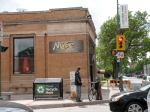A Placemaking Journal
[Holiday Leftovers] Confessions of a Former Sprawl Addict: Speed Humps on the Road to Recovery
 [Originally run Sept. 17, 2010] Hi. I’m Hazel and I was a Sprawlaholic.
[Originally run Sept. 17, 2010] Hi. I’m Hazel and I was a Sprawlaholic.
If you’ve been reading awhile you may recall that, with the loving help of my friends and family, I went cold turkey, dumping life in a Florida subdivision for the intense urban charms of downtown Winnipeg. It was a life-changing move with no regrets. Yet, as good as it’s been, I’m finding that puritanical denial of guilty pleasures is sometimes out of sync with life’s reality.
And by reality, I mean kids.
Simply put, T5 may have enormous benefits to offer but, in most cities, the needs of children — especially as they relate to education — are not among them. That’s why I’m turning to a temporary life in T3, the urbanist’s equivalent of controlled drinking. Yes, I’m imbibing somewhat on the intoxicating, have-it-all promise of suburban delights, but I’m doing it in a way that still honors my commitment to urbanism and placemaking.
I can stop any time. And, by any time, I mean when my son graduates high school.
While both offer amenity-rich single family dwellings, the big difference between our life in Winnipeg’s historic T3 neighborhood versus in a sprawling Florida subdivision is that here our complete community greatly reduces our ecological footprint while providing a satisfying quality of life. That’s because we’re moving to a compact (6 du/a), highly walkable T3 “sub-urban” (not to be confused with auto-centric “suburban”) neighbourhood, within one ped shed of three mixed use corridors. And we can remain a 1-car family, a block away from school, and a short bike or bus ride to downtown. So we’re still getting the annual benefits over the ‘burbs of 90% less carbon emissions, $17,206 car savings, $30,000 house savings, 700 hours, 10 pounds, and real community. These numbers aren’t counting the emmissions differential of the dwellings themselves, although the un-airconditioned century homes and complete streets do satisfy many Original Green requirements, per Miami architect, Steve Mouzon.
Still, what would make someone want to move from a Walk Score of 92 in the fabulous Exchange District to a Walk Score of 68?
For the reasons that most families in North America live in T2 and T3: schools and square footage. In order for us to remain a 1-car family, we can’t stay where we are as our son starts first grade this month. Not in the school that we feel is best suited for him. That, coupled with the higher prices in the urban core for family-sized accommodations, are the reasons families with children aged 6 to 18 are the demographic missing from city dwellers. In our 20-unit condo building alone, 3 families just left for these reasons, emptying the building of all 4 of its children.
What creative maneuvers are cities doing to try to keep an age-diverse population in their downtowns?
“You can’t rely on bringing people downtown, you have to put them there,” according to Jane Jacobs in her 1958 essay, Downtown is for People. Easier said than done. And even in this seminal article, Jacobs is looking for how to make the city “two-shift,” not 24-hour.
Toronto downtown population has grown by 20%, but a 3-bedroom condo in the core averages over $600,000. To prevent inner city schools from closing down and encourage economic diversity, steps are being considered to require affordable housing. However, how do we achieve this without meddling with markets in a downward cycle?
Vancouver made this critical decision in the ’80’s, with their “Living First” strategy, in which 8 million square feet of excess commercial was rezoned to mixed use, with heavy incentives for housing intensity and diversity within walkable, mixed-use, civic-minded neighbourhoods. Including schools! Developers are generally asked to pay for most of their own infrastructure cost, but without a form-based code to articulate the collective community vision, the question is still being asked, densify the core, or extend out?
Even in very livable downtowns like Seattle, only 2% of core households have children. Seattle Planning Director John Rahaim argues that families don’t need a particular kind of home, they need a community around it. “It’s having a school nearby and having kid-friendly open space nearby.”
Edmonton is thinking that the biggest issue is that cities typically bankroll sprawling development by paying for infrastructure to the suburbs. Reversing this would bring family-friendly housing and schools back in the money.
Would we have stayed downtown if our Montessori school went through grade 6? Most definitely! Just as with a certain number of rooftops bringing in a full service grocer, school options will follow. Or perhaps we should start thinking in the opposite direction, and tap into the unfilled needs of the parents among the 72,000 people who work downtown.
Until then, see you 5.6 km away in T3, where there are 13 kids on our block alone, under 12 years of age.







